|
Recent Designations in Coronado and San Diego
By A. Hayes and Ann Jarmusch
July/August 2018
San Diego County Historic Site Board Designates a Stone House
By A. Hayes and Ann Jarmusch
In March and April, the Coronado Historic Resource Commission designated three homes. The decision on a rare, 109-year-old home at 1405 Tenth Street was appealed by the owner and supported by many community members, including one fervently quoting the National Trust slogan, "This place matters." As you'll read below, the City Council upheld the designation.
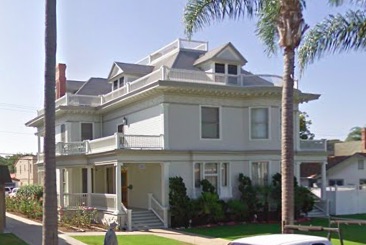 939 C Avenue in Coronado was designated on March 7 under Criteria A, B, C, and D. Under Criterion A, as a special element of the community, this residence was the Ritz Hotel during WWII for military personnel. Criterion B was met by an association with Captain Charles T. Hinde, who was instrumental in the development of early Coronado as one of the Coronado Beach Company's original directors. It was constructed in 1892 as an excellent example of the Colonial Revival style (Criterion C) and as a notable work of architect William Sterling Hebbard (Criterion D). Features include the hip roof with asymmetrical massing, boxed eaves, front porch with Ionic columns, pilasters, and dentil work throughout. 939 C Avenue in Coronado was designated on March 7 under Criteria A, B, C, and D. Under Criterion A, as a special element of the community, this residence was the Ritz Hotel during WWII for military personnel. Criterion B was met by an association with Captain Charles T. Hinde, who was instrumental in the development of early Coronado as one of the Coronado Beach Company's original directors. It was constructed in 1892 as an excellent example of the Colonial Revival style (Criterion C) and as a notable work of architect William Sterling Hebbard (Criterion D). Features include the hip roof with asymmetrical massing, boxed eaves, front porch with Ionic columns, pilasters, and dentil work throughout.
|
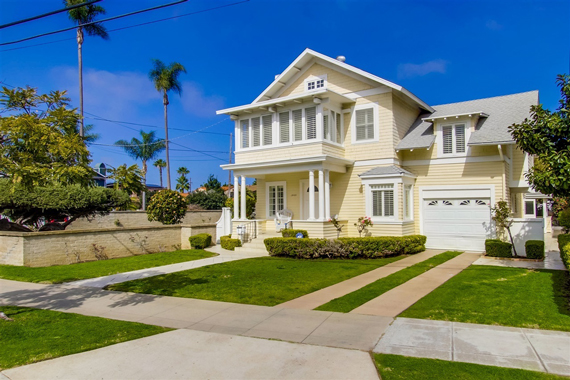 1405 Tenth Street in Coronado was designated on March 21 under Criteria B and C, but was brought forward with the intent to demolish. Constructed in 1909, the commission deemed this Arts & Crafts era house significant for resident Grace Healy, under Criterion B, an artist and designer involved with the Coronado Franklin Club and who designed portions of a home at 940 Glorietta Boulevard while living here. Also significant for the architectural style, the home's features include the gable roof, front porch with columns, both wood shingle and clapboard siding, and divided light wood windows. 1405 Tenth Street in Coronado was designated on March 21 under Criteria B and C, but was brought forward with the intent to demolish. Constructed in 1909, the commission deemed this Arts & Crafts era house significant for resident Grace Healy, under Criterion B, an artist and designer involved with the Coronado Franklin Club and who designed portions of a home at 940 Glorietta Boulevard while living here. Also significant for the architectural style, the home's features include the gable roof, front porch with columns, both wood shingle and clapboard siding, and divided light wood windows.
The owner appealed the designation to the City Council, which on April 17 upheld it. Although it determined 1405 Tenth Street was not significant under Criterion B for its association with Healey, it meets Criterion A as an example of the City's military history because an active duty military member has lived in the house since construction and during each U.S. war. The property was designated under Criteria A and C. Read the minutes HERE. The Historic Resource Commission subcommittee referred to is new and is gathering public input on improving the preservation program. Learn more HERE.
|
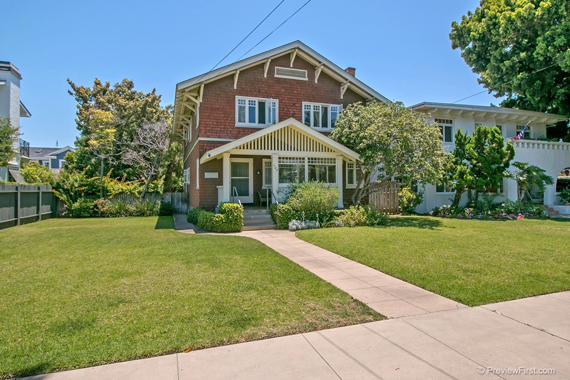 1109 F Avenue in Coronado was designated on April 4 under Criteria C and D as significant for the Arts & Crafts era architecture and its builder, S. D. Chapin. Built in 1913, features include the wood shingle siding, gable roof with deep eaves, exposed rafter tails, brackets, and divided light wood casement windows. Also significant as a notable work of Chapin, this is his only known work in the Arts & Crafts era style that remains intact. 1109 F Avenue in Coronado was designated on April 4 under Criteria C and D as significant for the Arts & Crafts era architecture and its builder, S. D. Chapin. Built in 1913, features include the wood shingle siding, gable roof with deep eaves, exposed rafter tails, brackets, and divided light wood casement windows. Also significant as a notable work of Chapin, this is his only known work in the Arts & Crafts era style that remains intact.
The City of San Diego designated a total of six historic resources in May and June. Its Historical Resources Board celebrated May as National Preservation Month and added two very special historical resources to the local register.
|
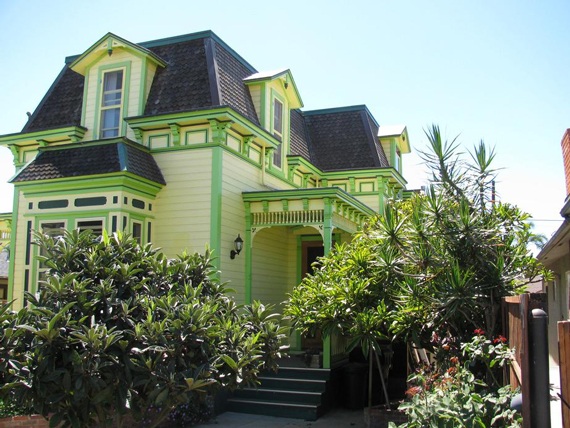 1930 30th Street in South Park is one of four remaining Second Empire style houses within the city. It was built downtown at 1546 A Street in 1887 and relocated to 30th Street in 1911, making it one of the first buildings in the South Park neighborhood. When downtown, it was the residence of George Copeland, who was instrumental in establishing the San Diego Flume and the first electric transit line in San Diego and on the west coast. Designated under Criterion C only, for exemplary architecture, its features include the mansard or double-hip roof, gabled dormers with stick work details, a projecting cornice, brackets, and bay window. SOHO presented the owners with a 2018 People in Preservation Award in May for their meticulous restoration of this iconic Second Empire style house. 1930 30th Street in South Park is one of four remaining Second Empire style houses within the city. It was built downtown at 1546 A Street in 1887 and relocated to 30th Street in 1911, making it one of the first buildings in the South Park neighborhood. When downtown, it was the residence of George Copeland, who was instrumental in establishing the San Diego Flume and the first electric transit line in San Diego and on the west coast. Designated under Criterion C only, for exemplary architecture, its features include the mansard or double-hip roof, gabled dormers with stick work details, a projecting cornice, brackets, and bay window. SOHO presented the owners with a 2018 People in Preservation Award in May for their meticulous restoration of this iconic Second Empire style house.
|
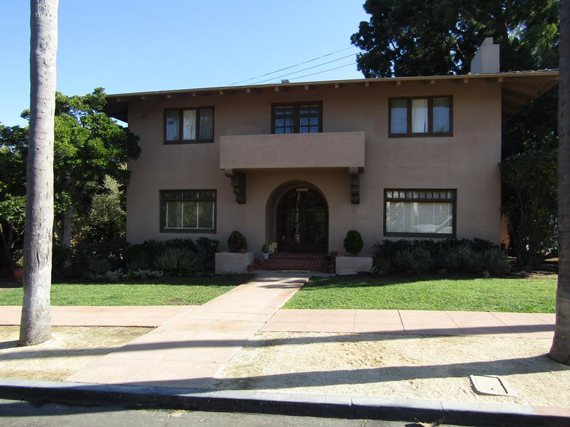 4239 Palmetto Way in Mission Hills illustrates the Spanish Colonial Revival style and, though not documented, appears to have been designed by Frank Mead and Richard Requa. Designated under Criteria A, B and C, this house is significant as a special element of the neighborhood, for an association with Philip Monroe Klauber, and as an excellent example of the style. Under Criterion A, this property is called out because it retains multiple plants from when this parcel was part of Kate Sessions nursery, prior to the 1914 house construction. Named the Philip Monroe Klauber house under Criterion B, Klauber was a prominent civic leader who lived for three decades in this residence. Awarded some of San Diego's highest honors, Klauber is recognized for his contribution to the local technical industry, cultural institutions, and social welfare organizations of San Diego. Also designated under Criterion C for exemplary architecture, its features include the low pitch hipped roof with deep eaves and exposed rafter tails, the front balcony with supporting brackets, multi-light French doors and transom windows, and much more. Additionally, a variety of interior elements were included within the designation such as the vast Gumwood molding, built-in features, and the conservatory's unique magnesite floor. 4239 Palmetto Way in Mission Hills illustrates the Spanish Colonial Revival style and, though not documented, appears to have been designed by Frank Mead and Richard Requa. Designated under Criteria A, B and C, this house is significant as a special element of the neighborhood, for an association with Philip Monroe Klauber, and as an excellent example of the style. Under Criterion A, this property is called out because it retains multiple plants from when this parcel was part of Kate Sessions nursery, prior to the 1914 house construction. Named the Philip Monroe Klauber house under Criterion B, Klauber was a prominent civic leader who lived for three decades in this residence. Awarded some of San Diego's highest honors, Klauber is recognized for his contribution to the local technical industry, cultural institutions, and social welfare organizations of San Diego. Also designated under Criterion C for exemplary architecture, its features include the low pitch hipped roof with deep eaves and exposed rafter tails, the front balcony with supporting brackets, multi-light French doors and transom windows, and much more. Additionally, a variety of interior elements were included within the designation such as the vast Gumwood molding, built-in features, and the conservatory's unique magnesite floor.
|
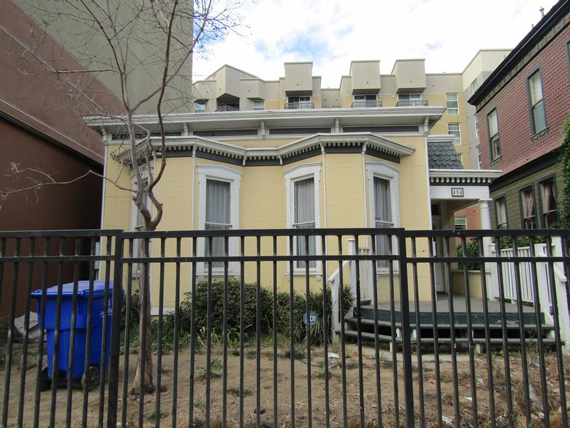 In June, the HRB designated four new resources, including a Custom Ranch that was once the residence of Abbe Wolfsheimer-Stutz. The board also made a recommendation to the Planning Commission for a Site Development Permit regarding 454 Thirteenth Street in the East Village, an important early Italianate style resource (c. 1887), which will remain on its original site with a new 7-story building above it, and include a 12' air space above the historic resource. In June, the HRB designated four new resources, including a Custom Ranch that was once the residence of Abbe Wolfsheimer-Stutz. The board also made a recommendation to the Planning Commission for a Site Development Permit regarding 454 Thirteenth Street in the East Village, an important early Italianate style resource (c. 1887), which will remain on its original site with a new 7-story building above it, and include a 12' air space above the historic resource.
|
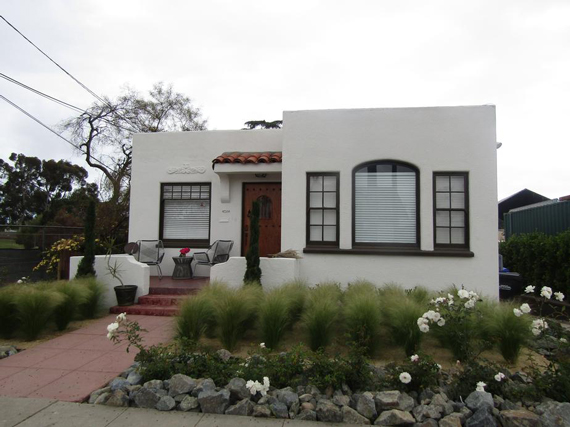 4030-4034 Randolph Street in Mission Hills is a Mission Revival style bungalow, constructed in 1927. Designated under Criterion C, as a good example of the style, features include the simple parapet, wood multi-pane and focal windows, door hood with brackets, and decorative relief work. Almost designated under Criterion B as well, this was once the residence of Pasquale Antonicelli, who immigrated to San Diego in 1913 and became Kate Sessions' longtime foreman. 4030-4034 Randolph Street in Mission Hills is a Mission Revival style bungalow, constructed in 1927. Designated under Criterion C, as a good example of the style, features include the simple parapet, wood multi-pane and focal windows, door hood with brackets, and decorative relief work. Almost designated under Criterion B as well, this was once the residence of Pasquale Antonicelli, who immigrated to San Diego in 1913 and became Kate Sessions' longtime foreman.
|
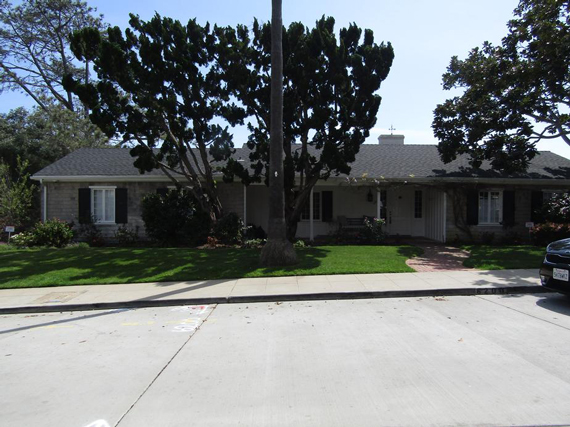 6200 Avenida Cresta in La Jolla is a 1937 Custom Ranch designed by Master Architect Thomas Shepherd. Designated under Criterion B, as the residence of Abbe Wolfsheimer-Stutz from 1976 until her death in 2014, Abbe passed the State Bar exam in 1973 and was a strong activist for women and the environment. She was instrumental in the establishment of the San Dieguito River Park and its managing nonprofit, the San Dieguito River Valley Conservancy. She was a San Diego City Councilmember for 8 years (1985-1993) and an author, among other achievements. 6200 Avenida Cresta in La Jolla is a 1937 Custom Ranch designed by Master Architect Thomas Shepherd. Designated under Criterion B, as the residence of Abbe Wolfsheimer-Stutz from 1976 until her death in 2014, Abbe passed the State Bar exam in 1973 and was a strong activist for women and the environment. She was instrumental in the establishment of the San Dieguito River Park and its managing nonprofit, the San Dieguito River Valley Conservancy. She was a San Diego City Councilmember for 8 years (1985-1993) and an author, among other achievements.
|
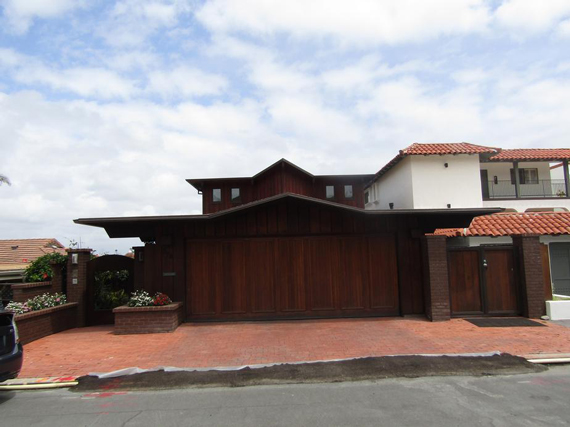 379 San Antonio Street in La Playa is designed in the Organic Geometric style by Master Architect Sim Bruce Richards. This 1961 resource is designated under Criteria C and D, as a good representation of the architectural style and as a notable example of this Master's work. The site-specific design with angular massing features "reversed" board and batten walls and chamfered rafters with open eaves. Because the 2016 partial-second story addition does comply with the Secretary of the Interior Standards, it is not included in the designation. 379 San Antonio Street in La Playa is designed in the Organic Geometric style by Master Architect Sim Bruce Richards. This 1961 resource is designated under Criteria C and D, as a good representation of the architectural style and as a notable example of this Master's work. The site-specific design with angular massing features "reversed" board and batten walls and chamfered rafters with open eaves. Because the 2016 partial-second story addition does comply with the Secretary of the Interior Standards, it is not included in the designation.
|
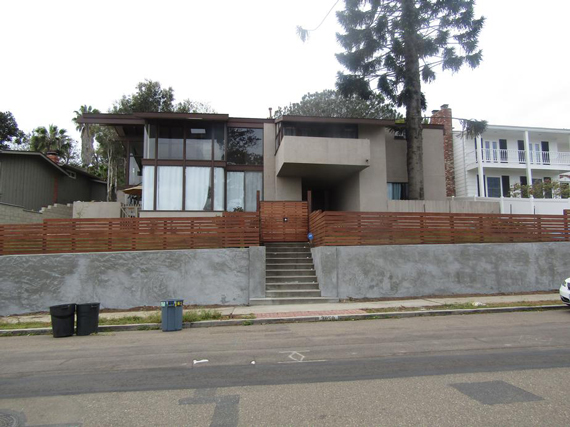 3950 La Cresta Drive in Point Loma Heights, built in 1971, illustrates the modern Post and Bean style. Designated under Criterion C as an excellent example of this style, character defining features include the expressed structural system, horizontal massing, shallow pitched roof, floor to ceiling glass walls, and skylights. 3950 La Cresta Drive in Point Loma Heights, built in 1971, illustrates the modern Post and Bean style. Designated under Criterion C as an excellent example of this style, character defining features include the expressed structural system, horizontal massing, shallow pitched roof, floor to ceiling glass walls, and skylights.
|
|
2025
2024
2023
2022
2021
2020
2019
2018
2017
2016
2015
|

 939 C Avenue in Coronado was designated on March 7 under Criteria A, B, C, and D. Under Criterion A, as a special element of the community, this residence was the Ritz Hotel during WWII for military personnel. Criterion B was met by an association with Captain Charles T. Hinde, who was instrumental in the development of early Coronado as one of the Coronado Beach Company's original directors. It was constructed in 1892 as an excellent example of the Colonial Revival style (Criterion C) and as a notable work of architect William Sterling Hebbard (Criterion D). Features include the hip roof with asymmetrical massing, boxed eaves, front porch with Ionic columns, pilasters, and dentil work throughout.
939 C Avenue in Coronado was designated on March 7 under Criteria A, B, C, and D. Under Criterion A, as a special element of the community, this residence was the Ritz Hotel during WWII for military personnel. Criterion B was met by an association with Captain Charles T. Hinde, who was instrumental in the development of early Coronado as one of the Coronado Beach Company's original directors. It was constructed in 1892 as an excellent example of the Colonial Revival style (Criterion C) and as a notable work of architect William Sterling Hebbard (Criterion D). Features include the hip roof with asymmetrical massing, boxed eaves, front porch with Ionic columns, pilasters, and dentil work throughout.










